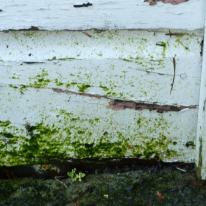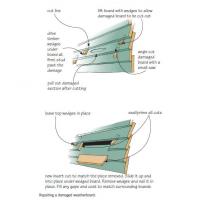Rot at base of timber weatherboard walls
Listed under: Exterior, finishes, timber and wood-based, paint, timber, cladding, walls, durability, rot, wall cladding, painted timber weatherboards
Cause
Boards are covered by soil or foliage
Repair
-
lower the soil or remove the foliage level so it is clear of the cladding – the bottom of the cladding must be able to dry completely. Leave a minimum 30–50 mm gap between the base of the timber and the ground to prevent moisture uptake. With suspended timber floors, ensure that lowering the garden level does not lead to surface water flowing under the house
-
check the extent of rot in the framing and bottom weatherboards with a screwdriver. Try to push it into the timber – if the screwdriver easily enters the timber, then the timber is rotten
-
replace all damaged or suspect supporting framing and weatherboards or sections of a weatherboard with treated timber. (If a weatherboard is badly affected by rot, replace the entire board rather than just sections.) When replacing timber use H3.2 treated timber for framing. For weatherboards, use H 3.1 timber with a 3-coat paint system (prime all surfaces before installation) or H3.2 treated timber. For weatherboard replacement:
-
splay (slant) cut back to nearest studs (at least 600 mm in both directions)
-
treat cut ends of existing boards with paint-on preservative
-
prime the back face and ends of new timber
-
insert new boards
-
nail edges of existing and new boards to studs using one nail per stud and board
-
prime
-
fill joints with exterior grade flexible (polyester) filler
-
paint with minimum two coats of semi-gloss or high gloss acrylic paint
-
where timber is sound, allow it to dry out completely. Scrape off loose coating and sand the bare timber until the surface is sound. Recoat with minimum two coats of semi-gloss or high gloss acrylic paint
-
for suspended timber floors, ensure good subfloor ventilation:
-
there should be not less than 3500 mm² of clear open subfloor venting for every 1 m² of floor area
-
ventilation openings should ideally be high in the subfloor space, near to the underside of bearers
-
vents should be spread evenly around the building perimeter to allow cross-ventilation
-
no part of the subfloor should be more than 7.5 m from a ventilation opening.
Cause
Boards have had concrete poured against them or are touching the ground
Repair
-
where possible, break up and remove concrete or paving. Reform the ground surface so there is a minimum 30–50 mm ventilation gap between the base of the timber and the ground or new paving. With suspended timber floors, ensure that surface water will flow away from the building
-
if concrete removal is impractical, cut off the base of the boards to provide a 30–50 mm gap for ventilation between the timber and the concrete. With suspended timber floors, ensure that surface water will flow away from the building
-
check the extent of rot in the bottom weatherboards and supporting framing with a screwdriver. Try to push it into the timber – if the screwdriver easily enters the timber, then the timber is rotten
-
replace all damaged or suspect framing, weatherboards or sections of weatherboards with treated timber. (If a weatherboard is badly affected by rot, replace the entire board rather than just sections.) When replacing timber use H3.2 treated timber for framing and for weatherboards use H 3.1 timber with a 3-coat paint system (prime all surfaces before installation) or H3.2 treated timber. For weatherboard replacement:
-
splay (slant) cut back to nearest studs (at least 600 mm in both directions)
-
treat cut ends of existing boards with paint-on preservative
-
prime the back face and ends of new timber
-
insert new boards
-
nail edges of existing and new boards to studs using one nail per stud and board
-
prime
-
fill joints with exterior grade flexible (polyester) filler
-
paint with minimum two coats of semi-gloss or high gloss acrylic paint
-
where timber is sound, allow it to dry out completely. Scrape off loose coating, sand the bare timber until the surface is sound. Recoat with minimum two coats of semi-gloss or high gloss acrylic paint.
-
for suspended timber floors, ensure good subfloor ventilation:
-
there should be not less than 3500 mm² of clear open subfloor venting for every 1 m² of floor area
-
ventilation openings should ideally be high in the subfloor space, near to the underside of bearers
-
vents should be spread evenly around the building perimeter to allow cross-ventilation
-
no part of the subfloor should be more than 7.5 m from a ventilation opening.
Cause
Boards were not primed and painted along the bottom edge
Repair
-
check the extent of rot with a screwdriver. Try to push it into the timber – if the screwdriver easily enters the timber, then the timber is rotten
-
replace all damaged or suspect framing and weatherboards or sections of weatherboards with treated timber. (If a weatherboard is badly affected by rot, replace the entire board rather than just sections.) When replacing timber use H3.2 treated timber for framing. For weatherboards use H 3.1 timber with a 3-coat paint system (prime all surfaces before installation) or H3.2 treated timber. For weatherboard replacement:
-
splay (slant) cut back to nearest studs (at least 600 mm in both directions)
-
treat cut ends of existing boards with paint-on preservative
-
prime back face and ends of new timber
-
insert new boards
-
nail edges of existing and new boards to studs using one nail per stud and board
-
prime
-
fill joints with exterior grade flexible (polyester) filler
-
paint with minimum two coats of semi-gloss or high gloss acrylic paint
-
ensure there is at least a 30–50 mm gap between the base of the timber and the ground
-
where timber is sound, allow it to dry out completely. Scrape off loose coating, sand the bare timber until the surface is sound. Recoat with minimum two coats of semi-gloss or high gloss acrylic paint
-
for suspended timber floors, ensure good subfloor ventilation:
-
there should be not less than 3500 mm² of clear open subfloor venting for every 1 m² of floor area
-
ventilation openings should ideally be high in the subfloor space, near to the underside of bearers
-
vents should be spread evenly around the building perimeter to allow cross-ventilation
-
no part of the subfloor should be more than 7.5 m from a ventilation opening.







